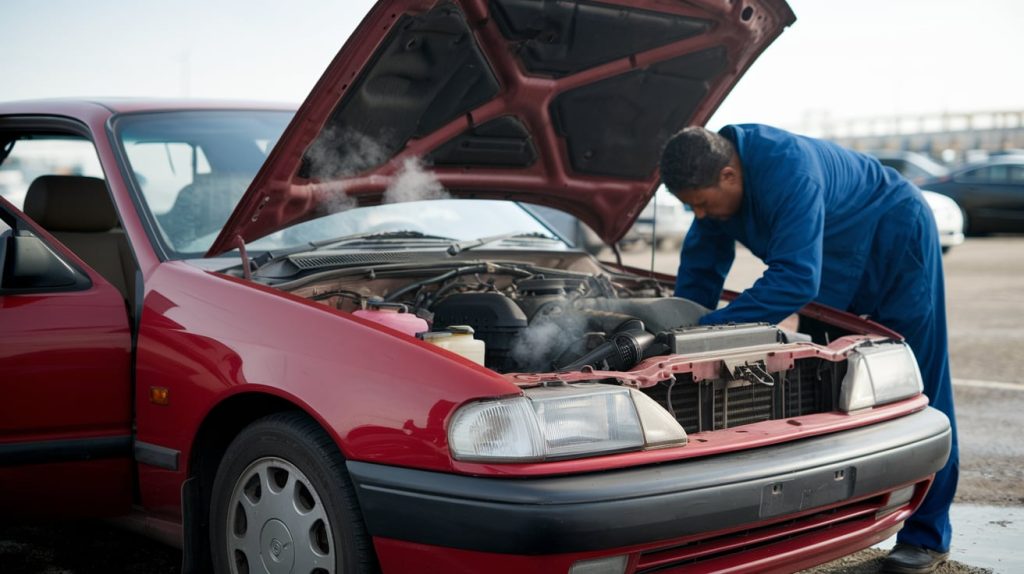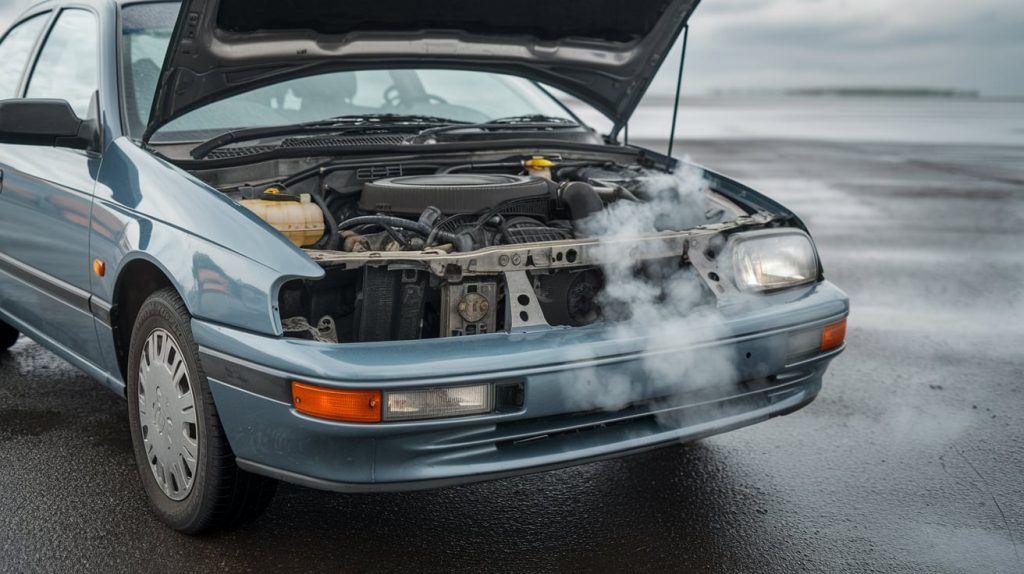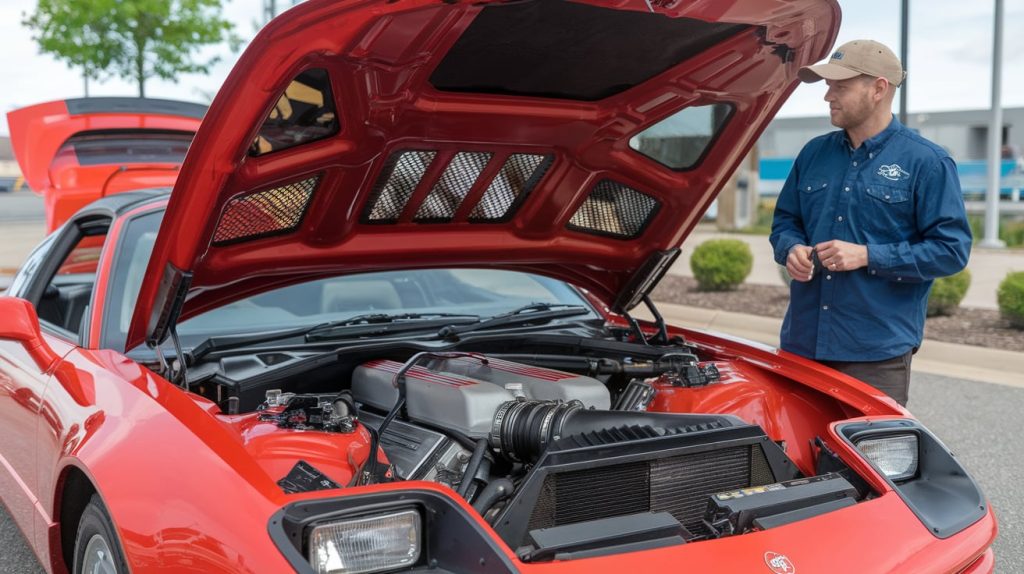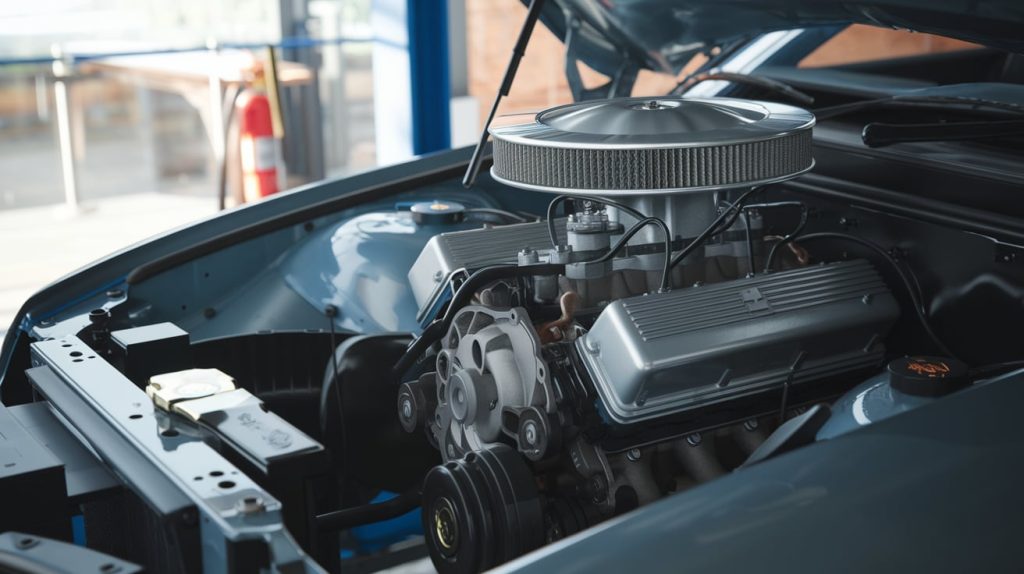There’s nothing more unsettling than seeing smoke coming from the engine while driving or parked, it’s your car’s cry for help! It’s a moment that sends alarm bells ringing, and rightly so! This isn’t just a minor inconvenience; it’s a warning sign that something under the hood needs immediate attention. Ignoring it can quickly turn a manageable issue into a full-blown catastrophe.
When you notice smoke coming from the engine, it’s often a sign of overheating, oil leaks, or even electrical issues. Each of these problems can compromise your vehicle’s safety and performance. For example, an oil leak burning on hot engine parts can damage vital components, while overheating can lead to engine failure. Don’t wait until your vehicle stops running! Addressing these issues promptly can save you from costly repairs and, more importantly, prevent dangerous driving conditions.
Your car’s engine is the heart of its performance, and recognizing smoke coming from the engine as a critical warning sign is essential to maintaining its health. In this blog, we’ll explore everything you need to know about engine smoke, from identifying its causes and types to understanding the risks of ignoring it.
We’ll also guide you through:
- diagnosing the issue,
- finding effective solutions,
- and preventing it from happening again
All while emphasizing the importance of prompt action to protect your safety, avoid costly repairs, and ensure your vehicle stays reliable on every journey.
Take action today your safety depends on it!
What Causes Smoke Coming from the Engine?
Seeing smoke coming from the engine is never a good sign, However, knowing the underlying problem might help you make the best decision. Your engine runs in harsh conditions, and several problems can cause that concerning smoke clouds. Let’s break down the most common causes.
1. Oil Leaks Burning on Hot Engine Parts
Oil spilling onto heated surfaces is one of the most common reasons for engine smoke. Smoke can be produced when oil leaks from broken gaskets or seals and drips onto heated surfaces like the exhaust manifold.
- You may notice a strong burning smell accompanying the smoke.
- Over time, this can damage your engine and escalate repair costs. Don’t wait until a simple leak becomes an expensive repair! Fix it at the first sign of smoke.
2. Overheating and Coolant Evaporation
Another significant factor contributing to engine smoke is overheating. Coolant may boil and evaporate when your engine temperature rises, resulting in white or light-colored smoke. This is often due to:
- Low coolant levels.
- A malfunctioning radiator or water pump.
- Blocked coolant passages. Ignoring these overheating issues can lead to engine damage or even complete failure. Act fast before your car leaves you stranded! If overheating is paired with AC troubles, you may also find this useful: How to Fix Common Car AC Problems in the UAE?
3. Electrical Faults
Although wiring and electrical parts are essential to your car’s functioning, they can malfunction. Dark smoke may emerge from beneath the hood as a result of wires or plastic casings overheating and burning due to defective wiring or short connections.
- You might notice a sharp, plastic-burning smell alongside the smoke.
- Electrical fires can spread quickly, so address them immediately to avoid dangerous situations.
4. Malfunctioning Head Gaskets or Seals
Internal coolant or oil leaks into the engine cylinders may be caused by a burst head gasket or broken seals. This leads to smoke coming from the engine, typically accompanied by a noticeable loss of power and performance. If left unresolved, it can result in catastrophic engine failure.
Identifying these causes early and taking action can save you from costly repairs and safety risks. Don’t ignore smoke coming from the engine get it checked out right away!
Don’t let engine troubles linger; our professional team is here to help you every step of the way.
Types of Smoke and What They Indicate
Not all smoke is the same, and the type of smoke coming from the engine can provide valuable clues about what’s wrong with your car. You can identify the issue and take the appropriate action to resolve it by paying attention to the color and consistency of the smoke.
1. White Smoke| Coolant Leaks or Engine Overheating
White smoke coming from the engine is often an indication that the coolant is burning because of a leak or overheating. It may smell a little sweet, and it usually means:
- A leaking head gasket allows coolant into the combustion chamber.
- Cracks in the engine block or cylinder head.
- An overheated engine causes coolant to evaporate. Visual clue: Thick, white smoke rising from under the hood, often accompanied by high engine temperatures.
Don’t wait overheating can destroy your engine if left unchecked!
2. Blue Smoke| Oil Leakage Into the Combustion Chamber
Blue smoke coming from the engine indicates that gasoline is burning together with oil that is seeping into the combustion chamber. This could be due to:
- Worn piston rings.
- Damaged valve seals.
- A faulty PCV (positive crankcase ventilation) valve. Visual clue: Thin, bluish smoke that appears consistently while driving. Ignoring this issue can lead to significant engine damage. Since oil burning is often linked with component failure, it’s also smart to review Why Does My Car Shut Off After Starting? for related issues.
Act quickly to prevent costly repairs!
3. Black Smoke| Fuel System Issues or Clogged Air Filters
Black smoke coming from the engine usually signals a fuel-related issue, like:
- An overly rich fuel mixture due to a faulty fuel injector or sensor.
- A clogged air filter prevents proper airflow.
- Malfunctioning spark plugs lead to incomplete combustion. Visual clue: Thick, dark smoke, often with a strong fuel odor. Don’t delay unresolved fuel system problems that can impact fuel efficiency and engine performance.
By understanding the type of smoke coming from the engine, you can pinpoint the issue and take swift action. Remember, no smoke is harmless. Whether it’s white, blue, or black, address it immediately to keep your vehicle safe and running smoothly.
Leave the guesswork to the experts schedule a service with us today and drive worry-free!
Risks of Ignoring Smoke Coming from the Engine
Ignoring smoke coming from the engine is comparable to operating a vehicle with a ticking time bomb underneath. What may begin as a minor problem can easily turn into a risky and expensive circumstance. Let’s examine the dangers of ignoring this warning indication.
- Safety Hazards: Smoke coming from the engine often indicates serious underlying issues, such as overheating, oil leaks, or electrical faults. These problems can lead to:
- Brake or steering failures due to engine overheating.
- Electrical fires are caused by burning wires or components.
- Sudden engine failure, leaving you stranded in unsafe conditions.
Don’t wait until it’s too late! Ignoring engine smoke puts you, your passengers, and other drivers at risk.
- Damage to Engine Components: When smoke coming from the engine is left unresolved, the damage can spread to critical parts like:
- The head gasket leads to coolant and oil mixing.
- Pistons, valves, and cylinder walls, may fail due to improper lubrication.
- The catalytic converter, can overheat or clog from unburnt fuel or oil. These repairs can cost thousands, and in severe cases, require a full engine replacement.
- Environmental Concerns: Emissions from unresolved engine smoke contribute to air pollution. Burning oil, coolant, or fuel releases harmful pollutants, violating environmental regulations and increasing your carbon footprint.
The risks of ignoring smoke coming from the engine far outweigh the inconvenience of addressing it.
Protect your safety, your wallet, and the environment act quickly to diagnose and fix the problem before it escalates!
How to Diagnose Smoke Coming from the Engine?
When you see smoke coming from the engine, Finding the source as soon as possible is essential to halting additional harm. Initially, diagnosing the issue doesn’t require expert knowledge; a simple examination can frequently provide a lot of information. To identify the problem, take the following actions:
1. Locate the Source of the Smoke
The first step in addressing smoke coming from the engine is trying to identify its source. Make sure the engine is off and cold before carefully opening the hood to check for:
- Areas with visible smoke or steam.
- Signs of burning oil, such as oily residue on hot engine parts.
- A plastic-burning smell that may indicate electrical issues.
2. Check for Leaks or Discoloration
Check the engine and its surrounding parts for:
- Leaks of oil, coolant, or other fluids dripping onto hot surfaces.
- Discoloration or residue around seals, hoses, or gaskets.
- Puddles beneath the car can signal fluid leaks contributing to smoke coming from the engine.
3. Monitor for Overheating Signs
One important diagnostic tool for your car is the temperature gauge. If the gauge displays high readings or steam is visible next to smoke coming from the engine, overheating is likely the culprit. This could stem from a faulty radiator, low coolant, or a broken water pump.
4. When to Seek Professional Diagnosis
It’s time to see a mechanic if the problem isn’t immediately apparent or if you detect lingering smoke or burning scents. A specialist can:
- Perform pressure tests to identify internal leaks.
- Inspect the electrical system for faults.
- Use diagnostic tools to assess engine performance.
Don’t wait until your vehicle stops running! Diagnosing smoke coming from the engine early prevents costly repairs and ensures your car stays safe and reliable.
When in doubt, trust our experts to diagnose and fix the issue—your car’s safety is our priority!
Fixing Smoke Coming from the Engine
Your car is trying to tell you that something is amiss when you detect smoke rising from the engine. Promptly resolving the problem can prevent costly repairs and serious harm. Here are the most common solutions to address smoke coming from the engine effectively.
1. Repair or Replace Leaky Components
Engine smoke is frequently caused by leaking coolant, oil, or other fluids. Resolving these leaks entails:
- Replacing worn-out gaskets, such as the head gasket or valve cover gasket.
- Repairing cracked or damaged hoses that allow fluid to drip onto hot surfaces.
- Sealing or replacing components where fluid leakage occurs. These repairs not only stop the smoke but also prevent further damage to the engine.
2. Flush the Cooling System
One of the main causes of engine smoke is overheating, which is frequently brought on by a malfunctioning cooling system. A cooling system flush can:
- Remove contaminants and restore efficient coolant flow.
- Address blockages in the radiator or cooling lines.
- Prevent future overheating by maintaining optimal engine temperature.
3. Replace Worn-Out Engine Components
Sometimes, the only solution for smoke coming from the engine is to replace failing parts. This might include:
- Damaged pistons or valves that cause oil to burn in the combustion chamber.
- Faulty sensors or injectors contribute to rich fuel mixtures.
- A malfunctioning catalytic converter or exhaust system.
4. Professional Repairs for Complex Issues
While minor fixes like replacing a hose can be done at home, most cases of smoke coming from the engine require professional expertise. A skilled mechanic can:
- Conduct in-depth diagnostics to find the exact problem.
- Ensure proper installation of new components.
- Prevent long-term engine damage by addressing the root cause.
Don’t wait until the damage worsens! Fixing smoke coming from the engine promptly restores your car’s safety and reliability, keeping you on the road with peace of mind.
Uncertain about the next steps? Let our trusted technicians handle the issue with precision and care.
Cost of Fixing Smoke Coming from the Engine in the UAE
Fixing smoke coming from the engine can differ in price based on the nature of the problem and the kind of car you own. To assist you in making your next move, below is a summary of typical repair expenses in the United Arab Emirates.
| Cause | Service Description | Cost Range (AED) | Luxury Cars (AED) |
| Oil Leak Repair | Repairing seals, gaskets, or minor oil leaks | 400 – 800 | 1,000 – 2,500 |
| Cooling System Flush | Flushing coolant, clearing blockages in the cooling system | 300 – 500 | 800 – 1,200 |
| Gasket or Seal Replacement | Replacing head gaskets or valve seals | 1,200 – 3,000 | 3,500+ |
| Electrical System Inspection | Diagnosing and fixing burnt wires or electrical faults | 500 – 1,500 | 2,000+ |
Note: Costs depend on your vehicle’s make and model, with luxury cars typically requiring specialized parts and labor.
Don’t wait if you see smoke coming from the engine, act immediately! Reach out to our most trusted garage in the UAE, to get a detailed quote and ensure your vehicle is repaired safely and efficiently.
If the problem feels overwhelming, rely on us to restore your car’s performance and safety.
Preventing Smoke Coming from the Engine
It’s always better to prevent than to treat, particularly when it comes to smoke coming from the engine. A little attention to maintenance can go a long way in avoiding costly repairs and ensuring your vehicle runs smoothly. Here are some essential tips to keep engine smoke at bay.
1. Regular Oil Changes and Fluid Top-Ups
Plan routine coolant top-ups and oil changes to maintain your engine fluids at their ideal levels. Low or dirty oil can cause overheating or leaks, which are common causes of smoke coming from the engine. Fresh oil and clean fluids keep the system running efficiently.
2. Inspect Hoses, Seals, and Gaskets
Look for indications of hose, gasket, and seal wear or damage during routine maintenance. Cracked or deteriorated components often lead to fluid leaks that can result in smoke coming from the engine. Replacing these parts early can save you from bigger problems later.
3. Avoid Overloading the Engine
Driving aggressively or carrying heavy weights are two examples of pushing your engine to its limits, which can put stress on its parts and cause overheating. This often manifests as smoke coming from the engine, signaling damage that could have been avoided with smoother driving habits.
4. Address Small Issues Promptly
Even while they might not appear urgent, small leaks, odd noises, or mild overheating can easily get out of hand. By taking quick action, these small problems can be avoided before they seriously harm the engine.
Don’t wait until smoke appears! Preventing smoke coming from the engine ensures your vehicle remains safe, reliable, and efficient for years to come. Stay proactive, and your engine will thank you!
FAQs About Smoke Coming from the Engine
- Can I drive with smoke coming from the engine?
No, driving with smoke coming from the engine is extremely risky. It could indicate severe issues like overheating, oil leaks, or electrical faults that can cause further damage or even a fire. Stop immediately and inspect the issue or consult a mechanic. - What’s the most common reason for engine smoke?
The most frequent cause of smoke coming from the engine is oil leaking onto hot components, followed by coolant evaporation due to overheating. - Does smoke always mean engine failure?
Not always, but it signals a serious problem that needs attention. Ignoring it can lead to engine damage over time. Always investigate the cause promptly.
Don’t ignore smoke coming from the engine it’s a sign your vehicle needs immediate attention! Protect your safety and avoid costly repairs by consulting a trusted mechanic today. Whether it’s a minor leak or a major issue, act now to restore your car’s reliability. Book your service now!
Your safety matters and our experienced team is ready to tackle any engine issue, big or small.





